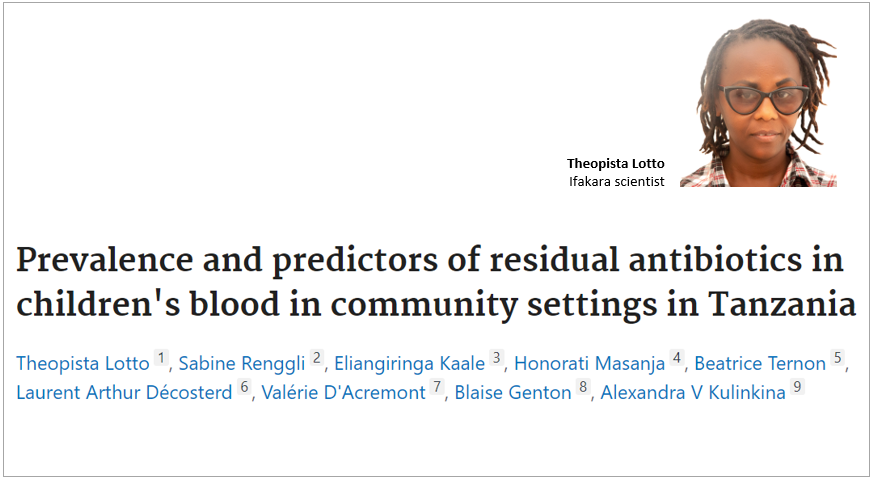
ANTIBIOTICS: Scientists call for new measures to regulate their use

Scientists from Tanzania and Switzerland have stressed the urgent need to address the complex issue of managing antibiotics in low- and middle-income countries (LMICs). This imperative action is crucial to ensure people who need these drugs can get them while also preventing overuse, which can lead to antimicrobial resistance (AMR).
Their recommendations come after uncovering a significant presence of residual antibiotics in the blood samples of children under 15 years in Mbeya and Morogoro regions of Tanzania.
Published on the Clinical Microbiology & Infection journal, the study reveals that 17.4% of surveyed children had detectable levels of antibiotics, raising concerns about overuse and the potential emergence of antimicrobial resistance.
Antibiotics are powerful medications designed to fight bacterial infections. They work by either killing bacteria or inhibiting their growth. Discovered in the early 20th century, antibiotics revolutionized medicine, saving countless lives and making previously fatal infections treatable. However, the misuse and overuse of antibiotics have led to the development of antibiotic resistance, a significant global health threat.
Uncovering alarming trends
In the study, the scientists, from Ifakara Health Institute, Swiss TPH, Muhimbili University (MUHAS), and the University of Lausanne, detail how young children in low- and middle-income countries are major consumers of antibiotics due to their higher frequency of illnesses and healthcare-seeking. They underscore that this trend results in over 60% of pediatric outpatient visits concluding with antibiotic prescriptions, often unnecessarily.
Insights into antibiotic consumption patterns
“A total of 1,742 children under the age of 15 were surveyed and 1,699 analyzed. The overall prevalence of residual antibiotics in the blood samples was 17.4% (296/1699), the highest among children under the age of five years. The most frequently detected antibiotics were trimethoprim (8.5%), sulfamethoxazole (6.0%), metronidazole (3.6%) and amoxicillin (2.5%),” reported the scientist.
According to the scientists, these findings align with data from the Tanzania Medicines and Medical Devices Authority, which lists doxycycline, amoxicillin, and co-trimoxazole as the most consumed antibiotics in the country.
Caution against long-term health risks
As a result of these findings, the scientists caution against the aftermaths of antibiotic exposure, writing, “This represents a shift from a historical lack of access to antibiotics to a new concern of excessive antibiotic exposure,”
“In addition to side effects, destruction of microbiota, and compromised immunity, exposure to antibiotics in childhood is linked to long-term health consequences, such as allergies, obesity, and neurodevelopmental disorders,” they added.
Factors associated with antibiotic exposure
Key factors linked with antibiotic exposure highlighted in the study include younger age, self-reported antibiotic consumption, observed antibiotic storage at home, and shorter travel times to healthcare facilities. The study also revealed higher antibiotic exposure among younger children and families with better access to healthcare and higher socioeconomic status.
Additionally, the scientists discovered some intriguing findings whereby half of the children who had antibiotics in their blood had no reported illness, did not report taking antibiotics, and had no antibiotics in their homes.
On this discrepancy, they suggested further investigation stating, “Further investigation of these findings is needed to determine if there is substantial under-reporting of risk factors or potential exposure from environmental sources since several of the detected antibiotics are also used in the agricultural sector in Africa and Tanzania.”
While the study was conducted during the COVID-19 pandemic, the scientists believe its results are generalizable to similar settings, shedding light on the significant overuse and potential misuse of antibiotics among children in Tanzania.
Antibiotic stewardship interventions
Conducted in Mbeya and Morogoro regions of Tanzania, this study provides vital insights into the high prevalence of antibiotic exposure among children. It reveals overuse and potential misuse which may be due to unreported self-medication or environmental pathways.
To manage the issue, the scientists recommend incorporating biomonitoring into surveillance strategies to help better understand exposure patterns and design antibiotic stewardship interventions.
“We recommend using objective measurements of antibiotic exposure in DBS samples in further studies and monitoring approaches, especially for antibiotics with longer half-lives. Conversely, developing more precise self-reporting instruments for antibiotics with short half-lives is needed. Clear labeling of antibiotics for community members to identify can help,”
“Together, these complementary approaches can yield better estimates of overall antibiotic exposure. Lastly, we recommend considering the one health approach in questionnaires to integrate animal, environmental, and human perspectives, broadening exposure knowledge and subsequent efforts to mitigate AMR,” they noted.
Ifakara scientist leads the study
The study was led by Theopista Lotto, a scientist at the Ifakara Health Institute also affiliated to the Swiss TPH. Lotto collaborated with fellow scientists Sabine Renggli and Honorati Masanja, both from Ifakara, as well as Eliangiringa Kaale from Muhimbili University of Health and Allied Sciences (MUHAS), Beatrice Ternon, Laurent Arthur Décosterd, and Blaise Genton from the University of Lausanne, and Valérie D'Acremont and Alexandra Kulinkina from Swiss TPH.
Read the publication here.
More: About antibiotics
Antibiotics are powerful medications designed to fight bacterial infections. They work by either killing bacteria or inhibiting their growth. Discovered in the early 20th century, antibiotics revolutionized medicine, saving countless lives and making previously fatal infections treatable. The most famous antibiotic, penicillin, was discovered by Alexander Fleming in 1928.
However, the misuse and overuse of antibiotics have led to the development of antibiotic resistance, a significant global health threat. When bacteria become resistant, they survive and multiply even in the presence of antibiotics, rendering standard treatments ineffective and leading to longer illnesses, more hospital stays, and increased mortality.
Combating antibiotic resistance requires a multi-faceted approach: appropriate prescription practices by healthcare providers, patient adherence to prescribed courses, reduced use in agriculture, and the development of new antibiotics. Public awareness and global cooperation are also crucial in managing this challenge. By taking these steps, we can preserve the effectiveness of antibiotics for future generations.
